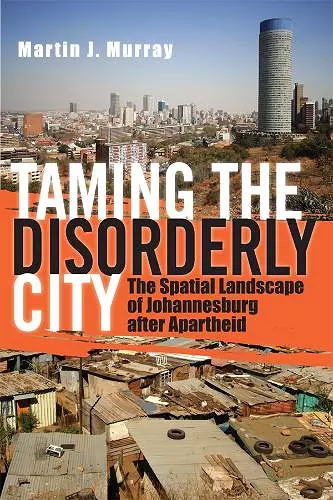Taming the Disorderly City
The Spatial Landscape of Johannesburg after Apartheid
Format:Hardback
Publisher:Cornell University Press
Published:15th May '08
Currently unavailable, and unfortunately no date known when it will be back
This hardback is available in another edition too:
- Paperback£27.99(9780801474378)

In postapartheid Johannesburg, tensions of race and class manifest themselves starkly in struggles over "rights to the city." Real-estate developers and the very poor fight for control of space as the municipal administration steps aside, almost powerless to shape the direction of change. Having ceded control of development to the private sector, the Johannesburg city government has all but abandoned residential planning to the unpredictability of market forces. This failure to plan for the civic good—and the resulting confusion—is a perfect example of the entrepreneurial approaches to urban governance that are sweeping much of the Global South as well as the cities of the North.
Martin J. Murray brings together a wide range of urban theory and local knowledge to draw a nuanced portrait of contemporary Johannesburg. In Taming the Disorderly City, he provides a focused intellectual and political critique of the often-ambivalent urban dynamics that have emerged after the end of apartheid. Exploring the behaviors of the rich and poor, each empowered in their own way, as they rebuild a new Johannesburg, we see the entrepreneurial city: high-rises, shopping districts, and gated communities surrounded by and intermingled with poverty. In graceful prose, Murray offers a compelling portrait of the everyday lives of the urban poor as seen through the lens of real-estate capitalism and revitalization efforts.
This is the kind of book one gets excited about reading from the first page onward. A chief reason for that is the propulsive energy and enthusiasm of Murray's engaging writing. Murray argues for seeing Johannesburg after apartheid as a city that remains divided against itself. He has three interwoven claims for post-apartheid Johannesburg: that the regeneration process and the road to ruin are two sides of the same coin; that it is very difficult to alter the urban landscape when it is physically so wedded to political-economic segregation and inequality; and that reliance on market mechanisms exacerbates the divisions of the city. Murrays four lines of argument around these claims might be described as emphasizing economic geography, socio-cultural aesthetics and discourse, urban governance, and the professional practice of urban planning. After a brief introduction, he lays out his case through eight theoretically engaged and empirically rich chapters. The content relies on a broad understanding of relevant literatures and on field research. Murray mixes data sources well, from interviews, detailed site visits to informal settlements, conversations with activists and residents, and news accounts.... This is a very strong book, ideally suited for use in urban geography and Africa geography courses.
* Journal of Cultural GeograpISBN: 9780801445699
Dimensions: 229mm x 152mm x 25mm
Weight: 907g
280 pages